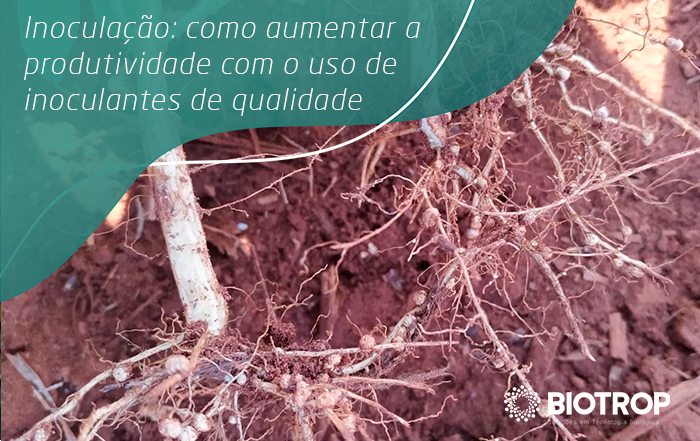Inoculation: understand what it is, tips on how to perform it, most important benefits and more!
Inoculation can be a powerful ally to achieve high productivity.
This technique can result in an increase in productivity of up to 8%, and, in case you opt for co-inoculation, increases can be as high as 16%.
However, in order to obtain higher profitability, understanding what inoculation is and its importance is crucial.
From this perspective, we have selected some information about inoculation and some tips on how to perform this technique on your property. Check them out!
What is inoculation?
The term inoculation refers to the addition of beneficial microorganisms to plants as so to enable the association between microorganisms and crops.
This association brings countless benefits to plants as follows: improved water and nutrient absorption, higher biological nitrogen fixation, and greater growth and development, resulting in higher productivity.
These beneficial microorganisms are sold as inoculants, which have biological characteristics, being referred to as biological inputs or bio-inputs.
Bradyrhizobium spp. is one of the most important microorganisms used to produce inoculants.
This genus promotes biological nitrogen fixation (BNF) for plants, and can be an excellent tool to replace or minimize costs of nitrogen fertilization, especially in legumes.
In actual practice, Bradyrhizobium spp will infect the roots of legumes, inducing plants to develop more nodules, in which the BNF process will occur.

Nodulated soybean root.
(Source: CompreRural)
Another example of a beneficial microorganism is Azospirillum spp, which enhances plant growth and biological nitrogen fixation.
Next, we are going to talk about the most important tips on how to perform inoculation on your farm successfully. Check them out!
3 tips on how to perform inoculation
1st Tip: Purchasing Products
A good inoculation or co-inoculation process starts with purchasing products correctly. In order to do so, you should be aware of some important aspects.
Firstly, make sure the product you have chosen is registered with MAPA, and check if it is within its expiration date.
After that, make sure the distributor stored and transported the product properly, that is, according to the recommendations on its label.
Always remember: inoculants are living beings and they need special care.
Some products have special characteristics that will likely help you in your everyday practices in the field, for example:
- Highly stable formulation, which ensures microbial viability;
- Compatibility with chemical products;
- Formulation or combination with bacterial protectors that enhance compatibility with seed treatment;
Therefore, before choosing a product, pay attention to these details!
Preferably, choose products that are compatible with agrochemicals, such as BIOTROP’s inoculants.
2nd Tip: Storage
After purchasing an inoculant or a co-inoculant, you should also consider this tip in order to maintain its quality..
Store the inoculants in a cool and well-ventilated place on your farm.
Opt for BIOTROP’s products because they do not have to be refrigerated and have a long shelf life (2 years), thus reducing their vulnerability to environmental conditions.
3rd Tip: Inoculant Application
The inoculants can be applied in two different ways: on-seed application, in-furrow application or even broadcast application during the first phenological stages of growing crops.
Regarding seed treatment, many inoculants cannot be applied with other products (insecticides and fungicides).
Thus, opt for products that are formulated with protectors that allow their use with other chemical products, or perform inoculation after treating seeds, as a second operation.
Inoculation or co-inoculation should be carried out on the sowing day, otherwise opt for specific formulations for pre-inoculation.
Cronos TSI, for example, allows inoculation up to 30 days before sowing.
Either liquid or peat inoculants can be used.
Regardless of their formulation, you must follow the manufacturer’s recommended doses, but you should check if this dose would ensure a minimum of 1.2 million cells per seed.
If you opt for in-furrow application, pay attention to the following steps:
Purchase good application equipment, which is compatible with your seeder and maintains the recommended dose from the beginning to the end of the application.
In addition, it is recommended that you follow the equipment in operation to better understand the feasibility of its use, checking its autonomy and if there are problems regarding seed tube clogging.
It is important to avoid these problems, as we are aware that the sowing window in many regions is not always long.
Regarding the dosage in this system, it is usually used from 2 to 10 times the inoculant dose for seed treatment.
And remember: it is crucial that you consult an agricultural engineer/agronomist so you can plan the management and position products successfully, according to your needs.
Benefits of inoculation and co-inoculation
In addition to nitrogen assimilation, the use of inoculation and co-inoculation in your crops can bring countless benefits such as:
- Better crop growth and development;
- Increases in productivity and profitability;
- Larger root systems, improving plant structure, thus reducing lodging;
- Increased resistance to water deficit;
- Increased efficiency in water and nutrient absorption;
- Induction of bacteria to produce phytohormones;
- Increased symbiosis with other growth-promoting bacteria.
By opting for BIOTROP’s inoculants, you will have guaranteed quality regarding their production, which will result in more benefits to your property.
Conclusion
Inoculation is an important ally to reach high productivity.
Understanding what inoculation is and its importance is crucial to the management of your crops.
In this article, you can also check some tips on how to perform inoculation on your property and the most important benefits of this technique
We hope that this information helps you to perform inoculation successfully on your property
Do you perform inoculation on your farm? Do you want to learn more about inoculation and BIOTROP’s products?

